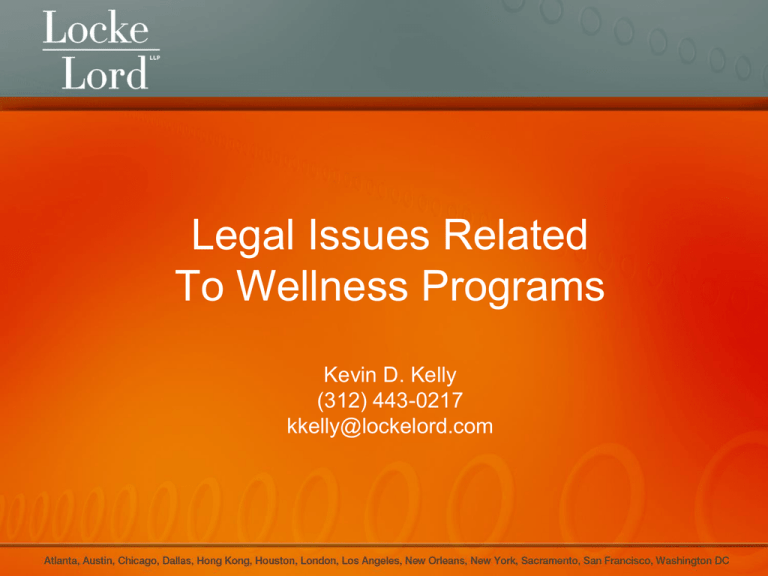Legal Issues Related to Wellness Programs
advertisement

Legal Issues Related To Wellness Programs Kevin D. Kelly (312) 443-0217 kkelly@lockelord.com Introduction And Overview • Many legal considerations when implementing a wellness program: – – – – HIPAA ADA GINA State law concerns • The law related to wellness programs isn’t welldeveloped – There are a number of areas of uncertainty at present – EEOC is becoming increasingly focused on wellness programs given the greater prevalence of these programs amongst employers The Range of Wellness Programs • Three levels of wellness programs 1. Purely voluntary programs with limited scope • Example: providing a fitness center on site for any employee who wants to use it 2. Participatory programs (for which all employees regardless of health can participate) that reward employees for engaging in the program • Examples: paying for employee gym memberships or paying a bonus to all employees who receive a preventive health screening 3. Detailed programs that reward or penalize employees depending on whether or not they actually attain certain health-related goals (health-contingent programs) • The higher the level of your program, the more legal issues arise HIPAA • Regulates participatory programs and programs that are health-contingent (levels 2 and 3 from previous slide) • If you want to implement a wellness program that has real carrots and sticks (as opposed to a purely voluntary program), you must comply with HIPAA Participatory Programs • Compliance with HIPAA simply requires that you offer the program to all similarly situated employees • Must remain distinct from a health-contingent program – Rewards are solely based on participation, not outcome – Exercise programs are not participatory – because some people might not be able to participate due to a health condition The Five-Part HIPAA Test For HealthContingent Programs • Distinction in the test between activity-only programs (e.g., exercise program) and outcome-based programs (e.g., rewarding those with healthy cholesterol or blood pressure) • The test has five elements The Five-Part HIPAA Test (continued) 1. The reward (e.g., health insurance premium rate reduction) is capped at no more than 30% of the total cost of coverage (which includes employer and employee portion) – Cap is 20% until January 1, 2014 – An additional 20% is available (after January 1, 2014) for programs designed to prevent or reduce tobacco use (50% total cap) – Percentage cap can be based on the cost of family coverage (as opposed to employee-only coverage) if the wellness program covers the employee’s family members The Five-Part HIPAA Test (continued) 2. The program must be reasonably designed to promote health and prevent disease – Relatively easy to meet this requirement 3. Employees must have an opportunity to qualify for the award at least once per year The Five-Part HIPAA Test (continued) 4. The program must be available to all similarly situated employees – To meet this requirement: • For an activity program, you must provide a reasonable alternative standard or waiver for anyone for whom it is unreasonably difficult or medically inadvisable due to a medical condition to meet the standard – • Can require medical proof For an outcome-based program, you must offer an alternative standard or waiver to anyone who fails to meet the initial target requirement regardless of why the person failed to meet the target – Cannot require medical proof The Five-Part HIPAA Test (continued) 5. The program must prominently disclose the alternative standard or waiver Reasonable Alternative Standards/Waivers • The most common source of problems for employers • Cannot simply say that employees must attain a health goal to qualify for reduced rates • Concrete examples – Tobacco usage – Healthy blood pressure/cholesterol – Participate in an exercise class ADA • Prohibits discrimination against individuals with disabilities • With the expanded definition of “disability” under the ADAAA, many people can claim some form of disability – My rule: everyone over the age of 40 has a disability ADA • Two ways in which the ADA affects wellness programs: 1. Any differentiation between employees based on health factors is potentially disability discrimination (e.g., providing discounted health insurance to those who are healthy and nondisabled) 2. Wellness programs can violate the ADA medical inquiry rules (which are stringent) • Law in this area is undeveloped and rapidly changing ADA – Discrimination in Health Insurance Rates • ADA prohibits discrimination in employee benefits (as well as other terms and conditions of employment) • But, the ADA contains a “safe harbor” provision allowing health plans to charge different premiums based on health factors • Seff v. Broward County – 11th Circuit expressly applies the safe harbor to a wellness program ADA Safe Harbor • Requirements – Must be able to show that the health factors (for which you are charging increased rates) actually result in increased medical costs • You can charge those with certain medical conditions more only if those conditions impose greater medical costs on your plan – Must treat all similar conditions in the same way • Cannot single out particular conditions for higher rates • Example: If you charge more for those with high blood pressure, you must also charge more for those with conditions that impose the same level of increased medical cost Compliance With The Safe Harbor • Technical compliance would require detailed medical information regarding how certain conditions affect total health insurance costs • The good news: by complying with the HIPAA reasonable alternative standard/waiver requirements, you likely avoid any issues with the ADA safe harbor – No one with a disability can complain that they couldn’t achieve the standard for reduced rates – EEOC: reasonable alternative standard is likely necessary as a “reasonable accommodation” under the ADA anyway ADA Medical Inquiry Rules • Once an employee is hired, an employer can inquire about an employee’s medical conditions only where the inquiry is “job-related and consistent with business necessity” • The problem: wellness programs necessarily make inquiries into employee medical conditions – For example, to determine if the employee has attained the wellness standard or target • Are wellness programs “job-related and consistent with business necessity”? The EEOC Position On Wellness Programs and Medical Inquiries • EEOC has not kept up with the increasing prevalence of wellness programs • Existing EEOC guidance: – Medical inquiries as part of a purely “voluntary” wellness program are permissible • Little guidance on what constitutes a “voluntary” program – Employer cannot require participation or penalize those who do not participate • Cannot terminate those who do not participate – Open question: is a reward offered to those who participate a penalty on those who do not participate? GINA • Prohibits discrimination based on genetic information and prohibits inquiries into the genetic history of employees • Implication for wellness programs – Health screenings and other questionnaires related to wellness programs sometimes involve inquiries into an employee’s family medical history – You should ensure that your wellness program doesn’t include any genetic history inquiries Use of Third Parties For Medical Inquiries • Can you escape potential liability for ADA or GINA inquiries simply by having a third party conduct the inquiries without disclosing the detailed results to you as the employer? – Not clear – Certainly better to keep distant from the results of these inquiries, but… – If you require an employee to respond to these inquiries in order to receive a wellness-related reward, you are still obligating an employee to respond to inquiries from an entity that is your agent • This could still violate the ADA or GINA regardless of whether or not you actually view the response to the inquiry State Law Issues • State statutes prohibiting discrimination based on the use of lawful products or lawful activities conducted outside of work – Indiana: tobacco use statute (specifically authorizes financial incentives intended to reduce tobacco use related to health benefits) – Examples of impact on wellness programs • Tobacco usage • Eating foods high in fat and cholesterol – Probably preempted by ERISA (which exclusively governs employee benefits like health insurance), but there has been almost no litigation on this issue State Law Issues • Liability for injuries at an employer’s gym or as part of an employer-sponsored fitness program – Very important to obtain a waiver (like you would sign at any gym) acknowledging the risks and waiving any liability for injuries sustained as part of the program Other Laws That Could Be Implicated By Wellness Programs • Title VII – religious discrimination – Religious objections to health screening or certain types of medical treatment • Title VII – race discrimination – Certain races have higher rates of certain health problems – Disparate impact claim potential • ADEA – older workers may have difficulty participating in certain activities Practical Considerations • You won’t convince employees that a wellness program is for their benefit (as opposed to simply saving the company money) if the company doesn’t have robust compliance with other laws pertaining to employee health – ADA reasonable accommodation – FMLA leave • Effective communication regarding the program can make a difference in how it’s received by employees – Employees are often hostile to health-based intrusions for privacy reasons – Resistance to being “told what to do” • Are outcome-based programs worth it because of the necessity of waivers/alternatives? Questions








